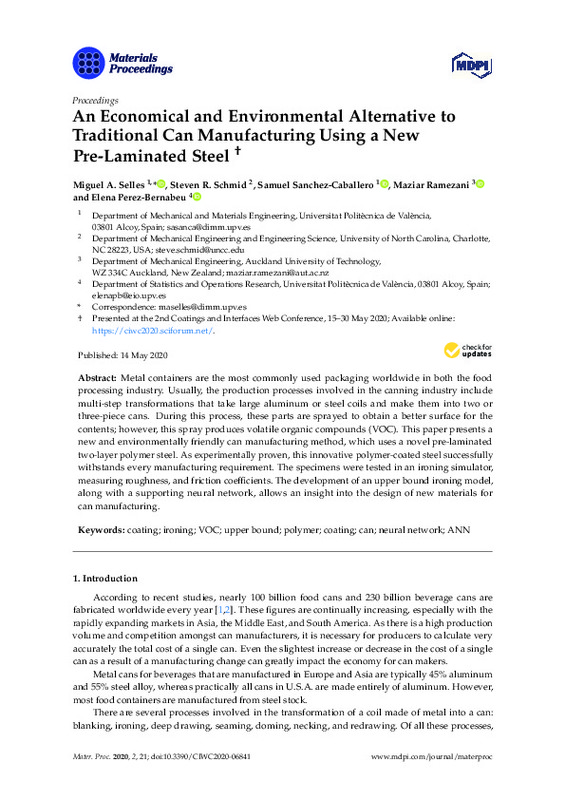JavaScript is disabled for your browser. Some features of this site may not work without it.
Buscar en RiuNet
Listar
Mi cuenta
Estadísticas
Ayuda RiuNet
Admin. UPV
An Economical and Environmental Alternative to Traditional Can Manufacturing Using a New Pre-Laminated Steel
Mostrar el registro sencillo del ítem
Ficheros en el ítem
| dc.contributor.author | Sellés Cantó, Miguel Ángel
|
es_ES |
| dc.contributor.author | Schmid, Steven R.
|
es_ES |
| dc.contributor.author | Sanchez-Caballero, Samuel
|
es_ES |
| dc.contributor.author | Ramezani, Maziar
|
es_ES |
| dc.contributor.author | Pérez Bernabeu, Elena
|
es_ES |
| dc.date.accessioned | 2021-09-14T03:32:53Z | |
| dc.date.available | 2021-09-14T03:32:53Z | |
| dc.date.issued | 2020-05 | es_ES |
| dc.identifier.issn | 2673-4605 | es_ES |
| dc.identifier.uri | http://hdl.handle.net/10251/172294 | |
| dc.description.abstract | [EN] Metal containers are the most commonly used packaging worldwide in both the food and beverage industry. Some manufacturing processes in the canning industry include multi-step transformations that take large aluminum or steel coils and make them into two or three-piece cans. During this process, the containers are sprayed to obtain a better surface for the contents; however, this spray produces volatile organic compounds (VOC). This paper presents a new and environmentally friendly can manufacturing method, which uses a novel pre-laminated two-layer polymer steel. As experimentally proven, this innovative polymer-coated steel successfully withstands every manufacturing requirement. The specimens were tested in an ironing simulator, measuring roughness and friction coefficients. The development of an upper bound ironing model, along with a supporting neural network, allows an insight into the design of new materials for can manufacturing. | es_ES |
| dc.language | Inglés | es_ES |
| dc.publisher | MDPI | es_ES |
| dc.relation.ispartof | Materials Proceedings | es_ES |
| dc.rights | Reconocimiento (by) | es_ES |
| dc.subject | Coating | es_ES |
| dc.subject | Ironing | es_ES |
| dc.subject | VOC | es_ES |
| dc.subject | Upper bound | es_ES |
| dc.subject | Polymer | es_ES |
| dc.subject | Can | es_ES |
| dc.subject | Neural network | es_ES |
| dc.subject | ANN | es_ES |
| dc.subject.classification | ESTADISTICA E INVESTIGACION OPERATIVA | es_ES |
| dc.subject.classification | INGENIERIA MECANICA | es_ES |
| dc.subject.classification | INGENIERIA DE LOS PROCESOS DE FABRICACION | es_ES |
| dc.title | An Economical and Environmental Alternative to Traditional Can Manufacturing Using a New Pre-Laminated Steel | es_ES |
| dc.type | Artículo | es_ES |
| dc.identifier.doi | 10.3390/CIWC2020-06841 | es_ES |
| dc.rights.accessRights | Abierto | es_ES |
| dc.contributor.affiliation | Universitat Politècnica de València. Departamento de Ingeniería Mecánica y de Materiales - Departament d'Enginyeria Mecànica i de Materials | es_ES |
| dc.contributor.affiliation | Universitat Politècnica de València. Departamento de Estadística e Investigación Operativa Aplicadas y Calidad - Departament d'Estadística i Investigació Operativa Aplicades i Qualitat | es_ES |
| dc.description.bibliographicCitation | Sellés Cantó, MÁ.; Schmid, SR.; Sanchez-Caballero, S.; Ramezani, M.; Pérez Bernabeu, E. (2020). An Economical and Environmental Alternative to Traditional Can Manufacturing Using a New Pre-Laminated Steel. Materials Proceedings. 2(21):1-10. https://doi.org/10.3390/CIWC2020-06841 | es_ES |
| dc.description.accrualMethod | S | es_ES |
| dc.relation.publisherversion | https://doi.org/10.3390/CIWC2020-06841 | es_ES |
| dc.description.upvformatpinicio | 1 | es_ES |
| dc.description.upvformatpfin | 10 | es_ES |
| dc.type.version | info:eu-repo/semantics/publishedVersion | es_ES |
| dc.description.volume | 2 | es_ES |
| dc.description.issue | 21 | es_ES |
| dc.relation.pasarela | S\417429 | es_ES |








